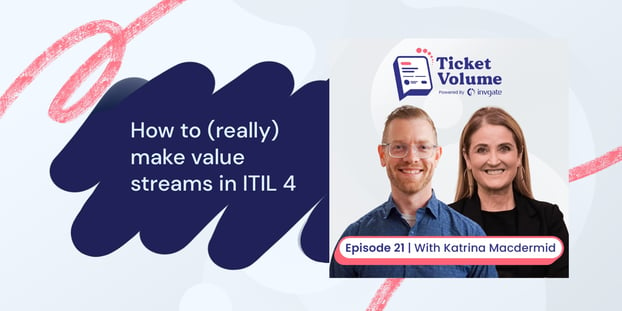ITIL 4 value streams have become a hot new topic for ITSM teams all over the world. The latest version of ITIL may have caused a learning curve for IT professionals and left a lot of room for discussion and elaboration.
Value streams are not new; in fact, the concept has been around since as early as the beginning of the 20th century in Ford’s factories. Now, ITIL 4 has leveraged value streams as a core concept in an attempt to deliver value to all stakeholders.
On the 21st episode of Ticket Volume, our host Matt Beran was joined by Katrina Macdermid, the author of "Humanising It: Human-centred design for IT Service Management." She is a consultant, educator, and ITSM Maturity Assessor. She has had years of experience working with Jetstar Airways, Qantas, and Amadeus, and won three global awards in ITIL training.
With her background and expertise, Macdermid gave some incredible insights into the good, the bad, and the to-be-improved of how to approach ITIL 4 value streams.
What went wrong with ITIL 4?
The creation of ITIL dates back to 1989, and so far there have been four updates of it, clearly evolving in how IT Service Management is handled in every era. In 2019, 8 years after ITIL v3, ITIL 4 was introduced as a more advanced and much-needed framework for Service Management, with a clearer focus on human-centered values and automation of processes. ITIL 4 emphasizes the service value chain, which not only is the backbone that runs the business but also helps it grow and transform.
Indeed, ITIL 4 is new and updated, but its adaptation is certainly not without faults: Macdermid pointed out that the focus on automation and efficiency has taken away the human element in Service and Process Management.
|
|
"The framework itself – and Service Management as a whole – never really considered the human experience of both the people we are here to serve and the people that are serving. " Katrina Macdermid |
For far too long, IT Service Management has been told to be more “customer-focused,” but how exactly to be that is still to be said. For Macdermid, the process as it is today is nowhere near customer-focused and much less human-centered.
And that’s exactly what service is supposed to be!
Even in the language that used in ITIL 4, customers are still called “users” without specifying who that may be, and what their motivation or background is. Moreover, process owners are not focused on creating these processes for their human customers, which led to too many outdated practices that are still used today.
In addition, the ITIL 4 co-author highlighted that the fact that people are still rigidly following the best practices in service management is preventing ITIL 4 from reaching its full potential. The massive change in customer behavior, especially because of poor experience with service desks, demands a shift in how value mapping is done. Users are not reading a 100-page manual, they are not consulting service desks, etc. These are all behaviors that ITIL 4 users have failed to predict.

ITIL 4 value streams: what’s the right mindset to build them?
ITIL 4 managed to be the best solution for better and more accessible service management all around. To optimize it, however, Macdermid suggested to approach value stream mapping in a more human-centered way.
She stated that one of the best things ITIL 4 introduced were the four dimensions of Service Management: Organization & People, Information & Technology, Partners & Suppliers, and Value Streams & Processes. In this sense, she suggested that people might have been too caught up in the whirlwind of technological advancements, which caused to focus more on tools than on the people aspect to create value streams and processes that actually resolve problems.
Specifically, Macdermid suggested to focus on the concept of “Issue to Resolution.”
By adapting this mindset, you can move away from the old, siloed way of thinking when it comes to IT Service Management. With this approach, all of the departments of ITSM – Incident Management, Problem Management, Knowledge Management, Partners Management, etc. – can be managed by one Value Stream Owner, who will find the right mix of all these processes and direct them all to one outcome: Resolution.
This mindset should help you better understand how to train your employees to be more customer-focused and design teams that best fit customers’ needs (Organization & People), deploy better tools for better services (Information & Technology), conduct productive meetings with suppliers that actually solve problems (Partners & Suppliers), and map better value streams overall.
To illustrate the “Issue to Resolution” principle, Macdermid used the fast food chain Mcdonald's. Customers choose it primarily for its main value chain: cheap and fast food. Knowing its customers, it chooses to deliver the value proposition through several value streams: UberEats, drive-thru, eat-in, etc. which all carry the brand’s principles at the heart of every journey.
|
|
"I find that companies are only investing in a foundational understanding of ITIL 4, so they missed what ITIL 4 is really about. We need to go to the next level, where we learn or do humanizing IT. That’s where we actually learn more about this concept of value stream mapping." Katrina Macdermid |
Key takeaways
The future of ITIL stays on human values. Katrina Macdermid is a strong advocate for humanizing the processes of service management. She pointed out exactly the way ITIL 4 is approached wrongly by not appropriately focusing on the human element, and instead heading straight to the process design based on best practices, which in turn:
- drives customers away from consulting service desks, and
- prevents process owners from creating processes that are up-to-date and human-centered.
To combat this, she suggested focusing on the service value chain and mapping value streams that can properly deliver that principle. By doing this, you are taking all the dimensions of ITIL 4 into account and creating better values for customers overall.















